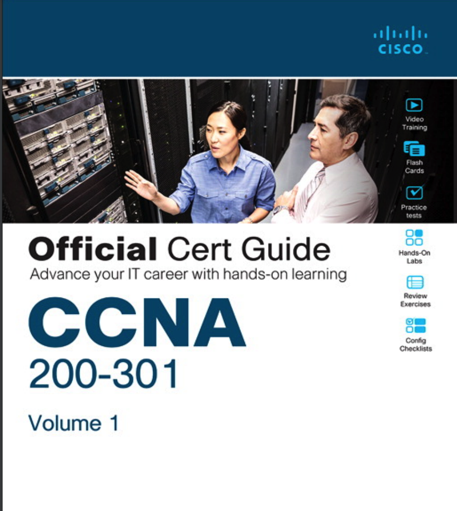2025 Latest Cisco Certified Network Associate (200-301 CCNA) Online Training
Day 1 | CCNA Training Course 1 -Network Fundamental
- Get what you need to pass the up-to-date Cisco CCNA 200-301 exam
- Gain hands-on Cisco CCNA configuration and troubleshooting experience through practice labs
- Explore how routing and switching technologies work in real world environments
- Develop skills to work on enterprise production networks
What you'll learn
Training Course Outline
Cisco Certified Network Associate (200-301 CCNA) Online Training
Day 1 | CCNA Training Course 1
Sub_01 Network Fundamental
Day 2 | CCNA Training Course 2 -IPv4 addressing & IPv6 addressing
Sub_01 CCNA Training Course 2 -IPv4 addressing & IPv6 addressing
Sub_02 IPv4 addressing & IPv6 addressing
Day 3 | CCNA Training Course 3 - Network Access
CCNA Training Course - Network Access
Sub_01 Describe switching concepts
Sub_02 Switching Concepts
Sub_03 VLANS
Training Options
Self Paced Learning
- Lifelong access to high-quality content
- Curated by industry experts
- Customized learning progress
- 24/7 learner assistance and support
- Follow the latest technology trends
Exam Dump
- 100% Real Exam Practice Tests
- 100% Verified Exam Questions & Answers
- 100% Guarantee Passing Rate
- Average 7 Days to Practice & Pass
Description
Level up your career in IT with this video-based online training course designed to help you master foundational networking skills and succeed on the CCNA 200-301 exam.The CCNA prep course provides hands-on training with core topics such as networking technologies, IPv4 and IPv6 addressing, Ethernet switching, routing, wireless networks, network services, and network programmability.
Pre-requisites
Absolute beginners to networking are welcome. Start with beginner level networking and explain every single acronym and concept you need to pass the exam.

CCNA 200-301 Official Cert Guide Library
CCNA 200-301 Official Cert Guide Library is a comprehensive review and practice package for the latest CCNA exam and is the only self-study resource approved by Cisco.
CCNA Exam & Certification
Networking Technologies in CCNA
Networking Technologies form the foundation of CCNA, covering the OSI and TCP/IP models, network topologies (LAN, WAN, MAN), and protocols like HTTP, DNS, and DHCP. Candidates learn to differentiate between wired and wireless infrastructures, understand data encapsulation/decapsulation, and troubleshoot connectivity issues using tools like ping and traceroute. Key concepts include bandwidth, latency, and network virtualization. Mastery of these principles enables professionals to design efficient networks and ensure reliable communication between devices, preparing them for advanced topics like routing and security.
IPv4 and IPv6 Addressing in CCNA
IPv4 and IPv6 addressing involve subnetting, VLSM (Variable Length Subnet Masking), and CIDR (Classless Inter-Domain Routing). IPv4 focuses on 32-bit addresses, private/public IP ranges, and NAT (Network Address Translation). IPv6 introduces 128-bit hexadecimal addressing, global unicast, and link-local addresses, emphasizing simplified routing and auto-configuration. Candidates learn to troubleshoot address conflicts, configure dual-stack environments, and implement IPv6 transition mechanisms (e.g., 6to4 tunneling). These skills ensure seamless integration of legacy and modern networks.
Ethernet Switching in CCNA
Ethernet Switching covers VLANs, trunking (802.1Q), and STP (Spanning Tree Protocol) to prevent loops. Candidates configure switchport security, port aggregation (EtherChannel), and inter-VLAN routing using Layer 3 switches. Key topics include MAC address tables, broadcast domains, and collision avoidance. Hands-on labs emphasize troubleshooting VLAN misconfigurations and optimizing network performance. Proficiency in switching ensures efficient Layer 2 operations, reducing latency and enhancing scalability in enterprise networks.
Routing in CCNA
Routing focuses on static and dynamic protocols (OSPF, EIGRP). Candidates configure static routes, OSPFv2/v3 for IPv4/IPv6, and route summarization. They troubleshoot routing loops, neighbor adjacency issues, and path selection using metrics like bandwidth and delay. Advanced topics include route redistribution and ACL-based traffic filtering. Mastery of routing ensures robust, scalable network designs, enabling seamless data flow across complex topologies.
Wireless Networks in CCNA
Wireless Networks cover WLAN fundamentals, including SSID configuration, authentication (WPA2/WPA3), and channel management. Candidates deploy lightweight access points (LAPs) and wireless LAN controllers (WLCs), troubleshoot interference using spectrum analyzers, and implement security protocols like EAP (Extensible Authentication Protocol). Topics like RF (Radio Frequency) principles and mesh networks prepare professionals to optimize coverage and performance in diverse environments.